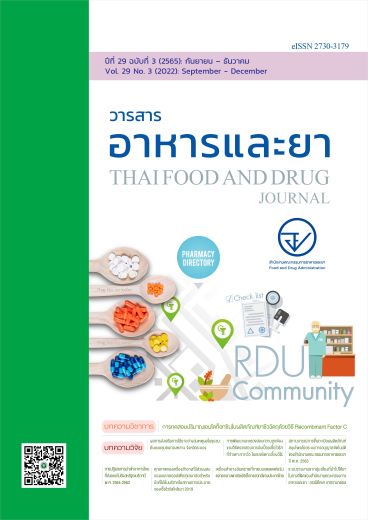เครื่องสำอางอันตรายที่ขายบนแพลตฟอร์มตลาดกลางพาณิชย์อิเล็กทรอนิกส์ของประเทศไทย
Main Article Content
บทคัดย่อ
ความสําคัญ: ปัจจุบันตลาดกลางพาณิชย์อิเล็กทรอนิกส์เป็นช่องทางซื้อขายเครื่องสําอางที่ผูบริโภคไทยนิยม มีแนวโน้มการเติบโตอย่างต่อเนื่อง ในขณะเดียวกันบนแพลตฟอร์ม e-marketplace ยังคงพบการขายผลิตภัณฑ์ที่ไมืถูกต้องตามกฎหมายไทย
วัตถุประสงค์: เพื่อศึกษานโยบายและคุณลักษณะของเว็บเพจมีการจําหน่ายผลิตภัณฑ์เครื่องสําอางบนแพลตฟอร์ม e-marketplace ที่นิยมของผู้บริโภคในประเทศไทย ศึกษาความครบถ้วนของฉลากและความถูกต้องด้านการโฆษณาตามกฎหมายประเทศไทย
วิธีการวิจัย: เป็นการวิจัยเชิงพรรณนา โดยเลือกกลุ่มตัวอย่างแบบเจาะจงจากเว็บเพจแพลตฟอร์ม e-marketplace ที่มีการลงจําหน่ายผลิตภัณฑ์เครื่องสําอางอันตรายที่นิยมของผู้บริโภคในประเทศไทยสูงสุด 2 ลําดับแรก กําหนดให้เป็นผู้ให้บริการ A และ B จากนั้นเก็บข้อมูลเว็บเพจผู้ใช้บริการโดยใช้คําค้นชื่อการค้าของเครื่องสําอางที่ห้ามผลิต นําเข้า หรือขาย ตามประกาศกระทรวงสาธารณสุข จํานวน 37 รายการ เก็บข้อมูลระหว่างวันที่ 3-10 มิถุนายน 2564 ใช้การวิเคราะห์เนื้อหาด้านคุณลักษณะและนโยบายการจําหน่ายผลิตภัณฑ์ของแพลตฟอร์ม และสถิติเชิงพรรณนาเพื่อแสดงความชุกของสถานการณ์ความครบถ้วนตามกฎหมายด้านฉลากและความถูกต้องด้านการโฆษณาเครื่องสําอาง
ผลการศึกษา: ผลการศึกษาเว็บเพจที่ขายผลิตภัณฑ์เครื่องสําอางบนแพลตฟอร์ม e-marketplace ของ A และ B พบว่ามีนโยบายการขายต่อผู้ประกอบการที่คล้ายคลึงกัน โดยให้ลงทะเบียนยืนยันตัวตนและนําสินค้ามาแสดงบนเว็บเพจหน่าซื้อขายได้อย่างอิสระภายใต้ข้อกําหนดของแพลตฟอร์ม ผู้บริโภคสามารถค้นหาสินค้า ผ่านเครื่องมือค้นหา (search engine) การเลือกชมรายละเอียดสินค้าที่สนใจผ่านข้อความภาพและอักษรและเข้าสู่ระบบการชําระเงิน และจัดส่งสินค้า มีเมนูการร้องเรียนปัญหา การใหัคะแนนรัานคัาหรือสินค้า และการแสดงความเห็นโดยผู้บริโภค (reviews) แต่ A มีการแสดงปริมาณการขายสะสมของสินค้าแต่ละรายการ นอกจากนั้น ทั้ง 2 แพลตฟอร์มมีข้อบังคับให้ผลิตภัณฑ์เสริมอาหารต้องระบุเลขสาระบบอาหารแต่ไม่ได้บังคับสําหรับหมวดเครื่องสําอาง เมื่อค้นหาการจําหน่ายเครื่องสําอางอันตรายที่ห้ามจําหน่ายตามประกาศฯ จํานวน 37 รายชื่อ พบว่าผู้ให้บริการ A และ B จําหน่ายในรายการดังกล่าว ร้อยละ 32.43 และ 27.04 ตามลําดับ มีเว็บเพจที่จําหน่ายเครื่องสําอางอันตราย จํานวน 200 เว็บเพจ เมื่อตรวจสอบความถูกต้องของการแสดงฉลากทั้ง 200 เว็บเพจ พบมีการแสดงภาพฉลากบนเว็บเพจ ร้อยละ 100.00 แต่ไม่มีผลิตภัณฑ์ใดระบุเลขที่ใบรับจดแจ้งบนฉลาก และพบการแสดงชื่อสารที่ใช้เป็นส่วนผสม ร้อยละ 41.70 ส่วนการโฆษณาพบความผิดในประเด็นการใช้ข้อความที่แสดงสรรพคุณเพื่อรักษาโรคมากที่สุด ร้อยละ 54.50 รองลงมาคือ การใช้ข้อความที่ทําให้เข้าใจผิดในสาระสําคัญ และข้อความที่เป็นเท็จหรือเกินจริง ร้อยละ 39.00 และ 9.00 ตามลําดับ
สรุป: มีการขายเครื่องสําอางอันตรายห้ามผลิต นําเข้า หรือขายบนแพลตฟอร์ม e-marketplace และพบความผิดในด้านฉลากและการโฆษณา โดยเฉพาะอย่างยิ่งการใช้ข้อความที่แสดงสรรพคุณเพื่อรักษาโรค ดังนั้นผู้มีส่วนเกี่ยวข้องควรเพิ่มมาตรการในการกํากับดูแล และเสริมกลไกที่ช่วยคุ้มครองผู้บริโภคบนอินเทอร์เน็ตที่เป็นระบบและมีประสิทธิภาพยิ่งขึ้น
Article Details

อนุญาตภายใต้เงื่อนไข Creative Commons Attribution 4.0 International License.
เอกสารอ้างอิง
1.สมาคมผู้ผลิตเครื่องสำอางไทย. เครื่องสำอาง ลุ้นโต 3.1 แสนล. ค่ายดังสปีดยอด [อินเทอร์เน็ต]. 2563 [เข้าถึงเมื่อ 28 ก.ย. 2564]. เข้าถึงได้จาก: https://thaicosmetic.org/index.php/tcmanews/news-from-media/76-3-1
2.กองพัฒนาศักยภาพผู้บริโภค สำนักงานคณะกรรมการอาหารและยา. คู่มือประกอบธุรกิจผลิตภัณฑ์สุขภาพ ฉบับผลิตภัณฑ์เครื่องสำอาง. กรุงเทพฯ: ศูนย์สื่อและสิ่งพิมพ์แก้วเจ้าจอม; 2563.
3.อภิษฐา ทรัพย์ประเสริฐ, จันทรรัตน์ สิทธิวรนันท์. การประเมินความคลาดเคลื่อนภายหลังออกสู่ตลาดของผลิตภัณฑ์เครื่องสำอางที่ได้รับการจดแจ้งโดยระบบการจดแจ้งอัตโนมัติ. วารสารอาหารและยา 2562;26(1):23-35.
4.เกษร ประสงค์กูล, ชิดชนก เรือนก้อน. การวิเคราะห์สถานการณ์การปนเปื้อนสารห้ามใช้ที่เป็นอันตรายในเครื่องสำอางสำหรับผิวหน้าในเขตอำเภอนางรอง จังหวัดบุรีรัมย์ ระหว่างปี พ.ศ.2556-2559. วารสารเภสัชกรรมไทย 2560;9(2):362-69.
5.วรรษพร คงชื่น, สงวน ลือเกียรติบัณฑิต. การพัฒนาเกณฑ์ประเมินความเสี่ยงต่อการปนเปื้อนสารห้ามใช้ที่เป็นอันตรายในเครื่องสำอางสำหรับผิวหน้า. วารสารเภสัชกรรมไทย 2564;13(4):814-824.
6.กระทรวงสาธารณสุข. ประกาศกระทรวงสาธารณสุข เรื่อง กำหนดชื่อเครื่องสำอางที่ห้ามผลิต นำเข้า หรือขาย พ.ศ. 2559. ราชกิจจานุเบกษา เล่มที่ 133, ตอนที่ 72 ง (28 มีนาคม 2559).
7.กระทรวงสาธารณสุข. ประกาศกระทรวงสาธารณสุข เรื่อง กำหนดชื่อเครื่องสำอางที่ห้ามผลิต นำเข้า หรือขาย (ฉบับที่ 2) พ.ศ. 2563. ราชกิจจานุเบกษา เล่มที่ 137, ตอนพิเศษ 177 ง (ลงวันที่ 3 สิงหาคม 2563).
8.สำนักงานพัฒนาธุรกรรมทางอิเล็กทรอนิกส์.รายงานผลการสำรวจพฤติกรรมผู้ใช้อินเทอร์เน็ตในประเทศไทย ปี 2563. [อินเทอร์เน็ต]. กรุงเทพฯ: สำนักงานพัฒนาธุรกรรมทางอิเล็กทรอนิกส์; 2563 [เข้าถึงเมื่อ 28 ก.ย. 2564]. เข้าถึงได้จาก: https://www.etda.or.th/getattachment/c5835c06-e238-4cda-9816-814df31caca5/IUB_2020_Web.pdf.aspx
9.ศูนย์จัดการเรื่องร้องเรียนและปราบปรามการกระทำผิดกฎหมายเกี่ยวกับผลิตภัณฑ์สุขภาพ สำนักงานคณะกรรมการอาหารและยา. ผลการดำเนินการเรื่องร้องเรียน [อินเทอร์เน็ต]. นนทบุรี: ศูนย์จัดการเรื่องร้องเรียนและปราบปรามการกระทำผิดกฎหมายเกี่ยวกับผลิตภัณฑ์สุขภาพ; 2564 [เข้าถึงเมื่อ 1 ก.ย. 2564]. เข้าถึงได้จาก: https://www.fda.moph.go.th/sites/HPSC/Document/%E0%B8%9C%E0%B8%A5%E0%B8%81%E0%B8%B2%E0%B8%A3%E0%B8%94%E0%B8%B3%E0%B9%80%E0%B8%99%E0%B8%B4%E0%B8%99%E0%B8%81%E0%B8%B2%E0%B8%A3/%E0%B8%9C%E0%B8%A5%E0%B8%94%E0%B8%B3%E0%B9%80%E0%B8%99%E0%B8%B4%E0%B8%99%E0%B8%81%E0%B8%B2%E0%B8%A3_64.pdf
10.ฐิติพร อินศร. การโฆษณาผลิตภัณฑ์เสริมอาหารที่ผิดกฎหมายในสื่อสังคมประเภทเฟซบุ๊กและข้อเสนอแนวทางบังคับใช้กฎหมายของพนักงานเจ้าหน้าที่. วารสารวิจัยและพัฒนาระบบสุขภาพ 2562;12(1):40-8.
11.พนิตนาฏ คำนุ้ย. การโฆษณาขายยาออนไลน์ที่ผิดกฎหมายและมาตรการดำเนินการ. วารสารอาหารและยา 2563;27(1):41-52.
12.Turban E, Whiteside J, King D, Outland J. Introduction to electronic commerce and social commerce. 4ed. New Jersey: Springer International; 2017.
13.สมจิตร ทองสุขดี, ณัฐสิรี หนูดา, ธีรยา วรปานิ. สถานการณ์และการจัดการด้านความปลอดภัยของเครื่องสำอางในจังหวัดสุโขทัย. วารสารอาหารและยา 2561;25(1):61-71.
14.เปมิษา วัชรนันทวิศาล. ปัจจัยที่มีความสัมพันธ์ต่อการตรวจพบสารที่มีฤทธิ์ทางยาปลอมปนในผลิตภัณฑ์อาหารที่กล่าวอ้างสรรพคุณลดน้ำหนักหรือเสริมสมรรถภาพทางเพศ [วิทยานิพนธ์ปริญญาเภสัชศาสตรมหาบัณฑิต]. นครปฐม: มหาวิทยาลัยศิลปากร; 2562.


